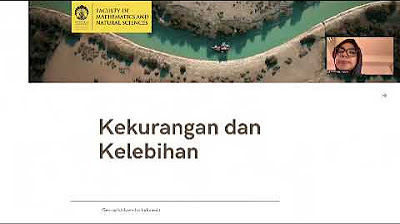Geografi Kelas XII (9) Pemanfaatan peta, penginderaan jauh, SIG untuk jaringan transportasi
Summary
TLDRThe video discusses the utilization of remote sensing in transportation networks, particularly focusing on its role in planning and development. It begins by defining transportation and its components, emphasizing the interconnectedness of vehicles, infrastructure, and the movement of people and goods. The presenter outlines the concepts of accessibility and trip generation as key parameters in transportation planning. Furthermore, the video highlights how remote sensing data can enhance understanding of land use, socio-economic conditions, and the inventory of transportation networks. By showcasing examples from Google Earth, it illustrates the practical applications of remote sensing in effective transport system planning.
Takeaways
- 😀 Remote sensing plays a crucial role in transportation planning by providing data on land use and traffic patterns.
- 🚍 Transportation is defined as a system enabling efficient movement of people and goods from one location to another.
- 🛣️ The transportation network consists of three main components: moving entities (people or goods), transportation modes, and transportation infrastructure.
- 📊 Accessibility is a key parameter in transportation networks, measuring how easily locations can be reached.
- 🚦 Planning transportation involves ensuring safe, efficient systems while considering environmental impacts.
- 🔄 The four stages of transportation planning include trip generation, mode selection, trip distribution, and route assignment.
- 📈 Remote sensing can provide temporal data, allowing for the analysis of land use changes over time.
- 🏙️ Different types of roads are categorized based on system, function, and status, affecting urban planning.
- 📍 High-resolution imagery from remote sensing helps in inventorying transportation infrastructure and assessing its condition.
- 📅 Understanding socio-economic factors and population density is essential for predicting transportation needs.
Q & A
What is the definition of transportation according to Papaostas?
-Transportation is defined as a system consisting of specific facilities based on flows and control systems that allow people or goods to move efficiently from one place to another.
What are the three main components of a transportation network?
-The three components are the moving entity (humans or goods), the means of transportation (vehicles), and the transportation infrastructure (roads).
How is transportation categorized based on road types?
-Transportation can be categorized into primary roads (national level) and secondary roads (urban areas), as well as by function (arterial, collector, local roads) and status (national, provincial, municipal).
What does accessibility mean in the context of transportation networks?
-Accessibility refers to the ease and comfort of reaching a location through the transportation network, which is influenced by the quality of transport means and infrastructure.
What is the significance of remote sensing in transportation planning?
-Remote sensing provides crucial data for land use analysis, socioeconomic conditions, and inventorying transportation networks, aiding in visualizing changes and assessing infrastructure.
What are the four stages of transportation planning models mentioned?
-The four stages are trip generation, mode choice, trip distribution, and route selection.
How does remote sensing contribute to inventorying transportation networks?
-Remote sensing allows for detailed visualizations of road conditions, types, and the overall layout of transportation networks, helping planners assess infrastructure quality.
What does the term 'movement generation' refer to?
-Movement generation refers to the factors that drive travel demand, including trip purpose, distance, land use, and available transportation modes.
What are the implications of poor accessibility in transportation systems?
-Poor accessibility can hinder interactions and limit the ease of reaching locations, leading to decreased mobility and potential socioeconomic impacts.
What role does socioeconomic data play in transportation planning?
-Socioeconomic data helps planners understand population dynamics and needs, influencing the design and adequacy of transportation systems.
Outlines

This section is available to paid users only. Please upgrade to access this part.
Upgrade NowMindmap

This section is available to paid users only. Please upgrade to access this part.
Upgrade NowKeywords

This section is available to paid users only. Please upgrade to access this part.
Upgrade NowHighlights

This section is available to paid users only. Please upgrade to access this part.
Upgrade NowTranscripts

This section is available to paid users only. Please upgrade to access this part.
Upgrade NowBrowse More Related Video

Pengolahan Citra Penginderaan Jauh untuk jaringan transportasi

PEMANFAATAN PETA DAN PENGINDERAAN JAUH DI BIDANG TRANSPORTASI

Pengindraan Jauh atau Remote Sensing #geography #education #kurikulummerdeka #remotesensing

Presentasi | Pendekatan dalam Penelitian Geologi : Penginderaan Jauh | - Kelompok 2 (ManRisGeo)

Kerja sama LAPAN di Bidang Penginderaan Jauh

Geografi Kelas XII (10) Pemanfaatan Peta, Penginderaan Jauh, dan SIG untuk Tata Guna Lahan
5.0 / 5 (0 votes)